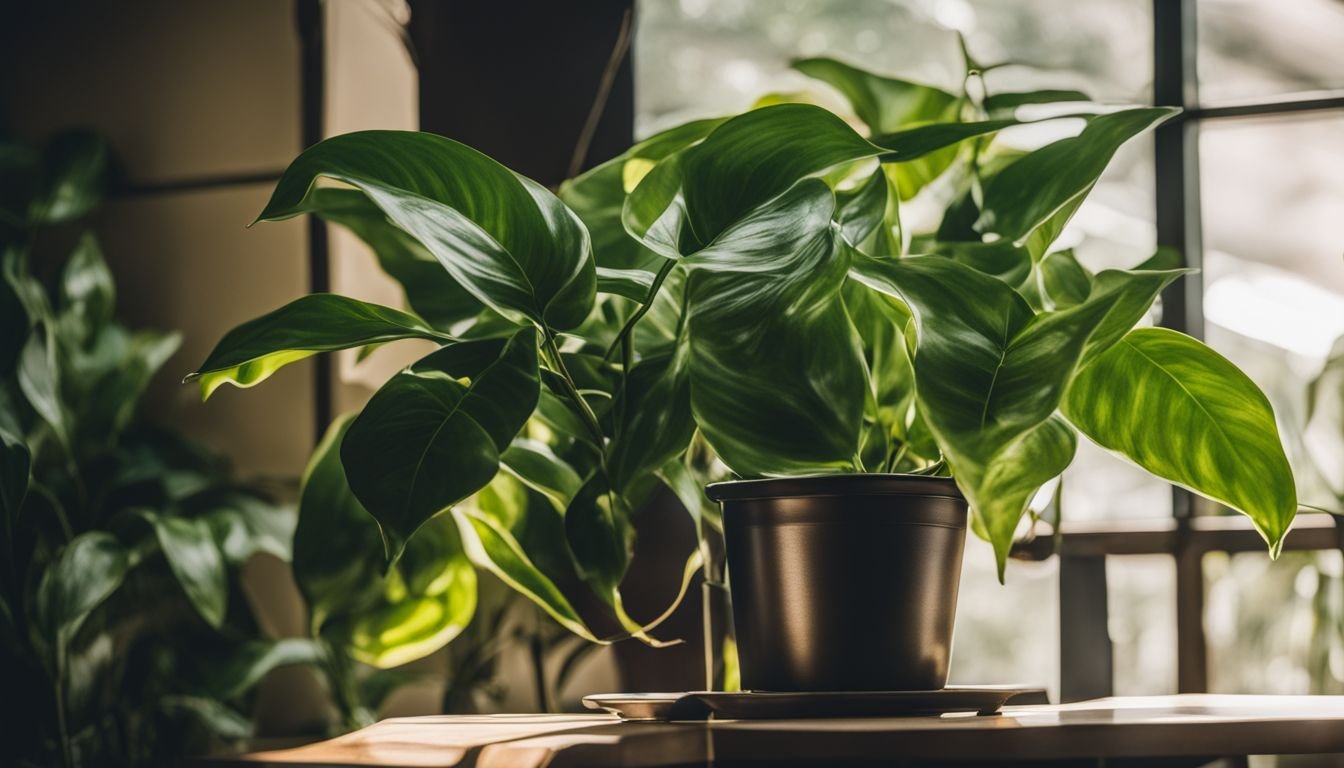Having a bit of a struggle keeping your Dragon’s Tail plant in top nick? You’re certainly not on your own. Plenty of us here in Australia are keen to bring that unique splash of green into our homes but often find ourselves scratching our heads, wondering why it’s not flourishing as we’d hoped.
The Dragon’s Tail, or Epipremnum pinnatum if you want to get technical, really makes an impression with its leaves that evolve in appearance as they mature, taking on the look of a dragon’s tail.
It adds a brilliant touch to any indoor space but can be somewhat finicky.
We’ve all watched helplessly as plants we adore just don’t seem to pick up no matter what we do. This drove me to really dive into understanding what these climbing beauties need to thrive.
After loads of reading up and trying different approaches, I’ve nailed down some key strategies that have been game changers for my plant care routine. This guide is about sharing those tips with you – from nailing the right light conditions, figuring out how often to water them without making puddles or deserts out of their pots, and mixing the perfect potting soil blend they’ll love.
By following through with this advice and adding your personal touch based on observing your own Dragon’s Tail reactions over time – because every Aussie home is different after all – you should start seeing some inspiring changes in its health and growth.
Fair dinkum, prepare yourself for some significantly cheerier plants!
Key Takeaways
- Keep your Dragon’s Tail plant in a spot with medium to bright light but away from direct sunlight, using sheer curtains if near windows. This helps avoid leaf burn while ensuring it gets enough light.
- Water the Dragon’s Tail when the top 3 – 5cm of soil feels dry to touch, preventing root rot by not letting water sit at the bottom of its pot.
- Feed your plant with balanced liquid food every 2 – 3 weeks during growing season and cut back to once a month during cooler months for optimal growth.
- Prune overgrowth and damaged leaves regularly to promote healthy foliage; repot into a slightly larger container every 1-2 years to give more room for growth.
- Watch out for pests like mealybugs and fungus gnats. Use a cotton swab dipped in alcohol for mealybugs or let the soil dry out to combat gnats. If root rot is suspected, remove mushy roots before replanting in fresh soil.
Key Factors in Dragon’s Tail Plant Care

Caring for a Dragon’s Tail plant means knowing just what it loves and needs. We make sure to shine the right amount of light on it, give it the proper amount of water, and feed it with nutrients to keep it happy.
Getting these factors right helps your indoor greenery thrive beautifully in its potting soil home.
This climbing beauty enjoys bright, indirect sunlight and feels best when its aerial roots have something to grip onto, like a stake or trellis in its container. We water our dragon tail plants when the top layer of soil dries out but never let them sit in water, as this can lead to root issues.
A bit of liquid food every now and then keeps those mature leaves looking vibrant and healthy.
Every so often, we take our pruning shears to trim any overgrowth or remove damaged foliage, encouraging more luscious growth. When they get too big for their pots, we pick a slightly larger one with fresh potting mix to give them more room.
Lighting and Positioning
To keep your Dragon Tail plant thriving, you need to get the lighting and positioning spot on. These plants love medium to bright light but not direct sunlight. Place them in a spot where they can soak up plenty of light without getting scorched.
Think about using sheer curtains to filter strong sun rays if you’re putting them near windows. This approach protects their mature leaves while letting enough light pass through.
Outdoor lovers have good news, too! In areas free from frost, our Dragon Tail plants enjoy living outside in partially shaded spots. They adapt well under trees or beside taller shrubs that provide some cover from harsh sunlight.
It’s like setting up a cosy nook for them outdoors where they can flourish alongside nature’s other beauties.
“Finding the perfect spot for your Dragon Tail is all about balancing shade and sunshine.”
Aim for spaces that mimic their natural habitat as closely as possible. Indoors, consider high shelves or hanging baskets where they can cascade down elegantly, showing off their aerial roots and lush foliage.
For those looking to create an indoor jungle vibe, pairing these with other house plants adds depth and variety to your green space.
Watering Requirements
After making sure your Dragon’s Tail plant gets the right amount of light, focus next on how much water it needs. This indoor climber likes its soil to be moist but not soggy. Check the potting mix and only add water if the top 3-5cm feels dry.
This method prevents root rot, a common issue that can harm or even kill your plant.
Use OCP eco-seaweed for watering occasionally; it helps the roots grow strong. If you live in a warm Australian climate without frost, you might choose to keep this plant outdoors where it enjoys partial shade.
Always use clean water and avoid overwatering to maintain healthy growth and vibrant leaves.
Regularly check your potted plants’ moisture level, especially during hot days since containers dry out faster than garden beds. Adjust your watering schedule based on temperature and rainfall, ensuring your Dragon’s Tail thrives whether inside or within outdoor water gardens under part shade conditions.
Fertilisation Guidelines
To keep your Dragon’s Tail plant thriving, use a balanced liquid food during its growing season. This type of feed is perfect for indoor climbers like the Dragon’s Tail. We recommend giving your green friend this boost every 2-3 weeks, which helps in promoting lush and healthy growth.
Make sure to follow the instructions on the liquid food package so you don’t give too much.
In the cooler months, ease back on feeding to once a month as your plant won’t be growing as much and doesn’t need as many nutrients. It’s crucial not to overdo it with fertiliser because too much can hurt your plant more than help it.
Keep an eye on how your plant responds after each feeding session and adjust accordingly for best results.
Understanding the Dragon’s Tail Plant Growth Characteristics

Dragon’s Tail plants, also known as Epipremnum pinnatum, exhibit a fascinating growth pattern that grabs our attention and sparks our gardening enthusiasm. As these indoor green wonders mature, their leaves transform dramatically.
Initially sporting simple shapes, they gradually evolve into complex forms with deep lobes echoing the appearance of a dragon’s tail. This unique characteristic not only adds an exotic touch to our homes but also showcases the plant’s dynamic nature.
Thriving both in the lush outdoors of tropical climates and inside under medium to bright light conditions, Dragon’s Tail proves versatile for Australian gardeners. We must ensure they receive enough warmth and humidity to mimic their natural habitat for optimal growth.
Regular repotting gives them ample space to spread their roots and flourish, marking an essential step in nurturing these climbing plants.
Moving forward, we tackle common issues that might arise with your Dragon’s Tail plant, ensuring it remains healthy and vibrant.
Dealing with Common Dragon’s Tail Plant Issues
We all know taking care of indoor plants can be tricky, and the Dragon Tail plant is no exception. Here’s how we tackle the most common problems you might face with your Rhaphidophora decursiva, also known as Epipremnum pinnatum.
- Keep an eye out for mealybugs. These tiny pests love to eat at your plant’s leaves, sucking out its life force. You can spot them by their white, cottony coating. To get rid of these bugs, dab them with a cotton swab dipped in alcohol or apply an insecticide like OCP eco-neem following the instructions on the bottle.
- Watch for signs of root rot. This problem often happens when we overwater our plants, leaving the roots too soggy. Make sure your Dragon Tail’s pot has good drainage and let the soil mostly dry out before watering again. If you suspect root rot, carefully remove your plant from its pot and trim away any mushy roots before replanting in fresh soil.
- Browning leaves can be a sign of trouble. Sometimes it’s due to too much direct sunlight or not enough water. Move your plant to a spot where it gets plenty of indirect light and keep the soil moist but not waterlogged.
- Fungus gnats are small flies that buzz around indoor plants when there’s too much moisture in the soil. These pests can harm young plants by eating their roots. To fight them off, let the top layer of soil dry out between waterings or use sticky traps to catch adult gnats.
- Your Dragon Tail might need more room to grow if it’s been in the same pot for too long. We should repot it every 1-2 years into a slightly larger container with fresh potting mix to give its roots space to spread.
Since this plant is toxic, always wear gloves while handling and keep it away from children and pets.
Our next topic will guide you on ensuring your Dragon Tail Plant remains healthy and vibrant year-round.
Conclusion: Ensuring a Healthy and Vibrant Dragon’s Tail Plant
Caring for your Dragon’s Tail Plant brings joy and a touch of the tropics to your Australian garden. With proper sunlight, watering, and feeding with seaweed and amino acids, these striking plants will thrive.
Don’t forget, every year or two, give them more space to grow by repotting them. Using moss poles or wire frames helps them climb and show off their beauty. Start cuttings in water; once roots appear, move them to fresh soil mix for new growth.
Happy gardening!
FAQs
1. How do I feed my Dragon’s Tail Plant?
Use liquid fertiliser to give your Dragon’s Tail Plant, also known as Epipremnum aureum, the nutrients it needs. This helps it grow healthy and strong.
2. Can I grow a new Dragon’s Tail Plant from stem cuttings?
Yes, you can! Take stem cuttings of your plant and put them in water or soil. With some care, they’ll start growing into new plants.
3. Should I prune my Dragon’s Tail Plant?
Absolutely! Pruning helps keep your plant tidy and encourages more growth. Just snip off any long or unwanted parts.
4. What other plants can I grow with my Dragon’s Tail Plant?
Your Dragon’s Tail will love being around lavenders, tomatoes, olives, citrus trees, herbs like mint, and flowering ornamentals like camellia.
5. Is it okay to transplant my Dragon’s Tail Plant outdoors in Australia?
Sure thing! Just make sure you choose a spot that suits its needs for light and space. Don’t forget to add some mulch around it after transplanting to help retain moisture.
6. How does caring for my plant affect aquatic life in nearby waters?
Be mindful when using fertilisers as they can run off into lakes and rivers causing low oxygen levels which harm fish kills and other aquatic life.
